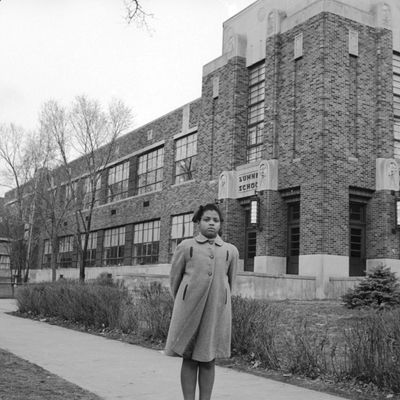
Linda Brown, the 12-year-old girl who was the subject of the unanimous 1954 Supreme Court decision that outlawed formal school segregation, died today at the age of 76.
Linda’s father, Oliver, was actually the plaintiff in Brown v. Board of Education. He filed suit after the school board would not let him enroll Linda in an all-white elementary school near their home. By the time the case reached SCOTUS, it had been consolidated with challenges to segregated school systems in three other states (and the District of Columbia). But it was always known by Brown’s name.
While Brown dealt an ultimately fatal blow to the constitutionality of formally (or “de jure”) segregated schools, overruling the 1896 Plessy v. Ferguson decision that allowed “separate but equal” facilities for different races, the 1954 decision began a long and difficult process of achieving educational equity that continues today. Brown itself required that states undertake desegregation with “all deliberate speed,” which enabled many years of foot-dragging and indirect strategies for maintaining mostly segregated schools, ranging from “freedom of choice” plans that let white parents move their kids out of integrated schools to the fight against “busing” to achieve something like racial balance.
It speaks volumes that Linda Brown herself had to keep up the struggle as an adult, as the Topeka Capital-Journal reports:
In 1979, Linda Brown, now with her own children in Topeka schools, became a plaintiff in a resurrected version of Brown, which still had the same title. Topeka Capital-Journal archives indicate the plaintiffs sued the school district for not following through with desegregation.
Federal Judge Richard Rogers sided with the school district in a 1987 decision, but an appeals court reversed his ruling in 1989 and the Supreme Court hose not to review that decision. Rogers then approved a desegregation plan for Topeka Unified School District 501 in 1993.
You can certainly make the argument even now that the spirit of Brown is being defied by those seeking to let parents use public funds to enroll their kids in private schools, providing a different but often parallel means of segregating students.
Linda Brown is now being honored both by those who recognize the legacy of Brown v. Board of Education as incomplete, and those who very much want to limit it to its original scope of de jure (as opposed to de facto) segregation. That’s inevitable, and arguably even a good thing, though you have to figure she would have wanted present and future parents and children to be so secure in their rights they’d no longer have to keep fighting the same battle she began.






























